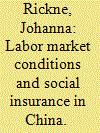| Srl | Item |
| 1 |
ID:
124545


|
|
|
|
|
| Publication |
2013.
|
| Summary/Abstract |
This paper provides micro-level evidence on the relationship between labor market conditions and social insurance participation among Chinese industrial firms. I find that the increased scarcity of labor over this period was a quantitatively important driver of participation. Moreover, a comparison of the responses in different segments of the labor market shows that the response was relatively stronger in sectors with larger shares of uninsured workers, namely in private firms, those with a larger share of low-educated workers, and those without labor unions. The results suggest that a tighter labor market in the years ahead can aid policy makers to implement social insurance programs and combat insurance inequality.
|
|
|
|
|
|
|
|
|
|
|
|
|
|
|
|
| 2 |
ID:
124562


|
|
|
|
|
| Publication |
2013.
|
| Summary/Abstract |
Despite the "growth miracle" of recent decades, labor's share, i.e., the share of total labor compensation in GDP, has decreased in China. Labor's share is an important indicator of the primary distribution of national income, and its fall has drawn significant attention from researchers and policymakers. As China's many regions have different development levels and economic structures, it is very likely that labor's share will differ across regions. Thus, it is important to examine the regional disparity of labor's share. In this paper, we develop a conceptual framework based on existing theories to identify the factors that influence labor's share. We, then, use Chinese provincial data from 1997 to 2007 to describe the regional differentials in labor's share and its evolution over the 10-year period and to explain regional disparity in labor's share. We take into consideration spatial correlations across regions and employ spatial cross-sectional and panel models in the empirical analysis. We found that industrial composition and ownership structure were the two key factors that influence labor's share. We also found that the average labor income was lower but labor's share was higher in western areas compared to eastern areas. The higher levels of labor's share in western provinces may be explained by a higher share of agricultural industries and state-owned enterprises, as agriculture and state-owned sectors tend to distribute more income to labor than to capital.
|
|
|
|
|
|
|
|
|
|
|
|
|
|
|
|
| 3 |
ID:
084773


|
|
|